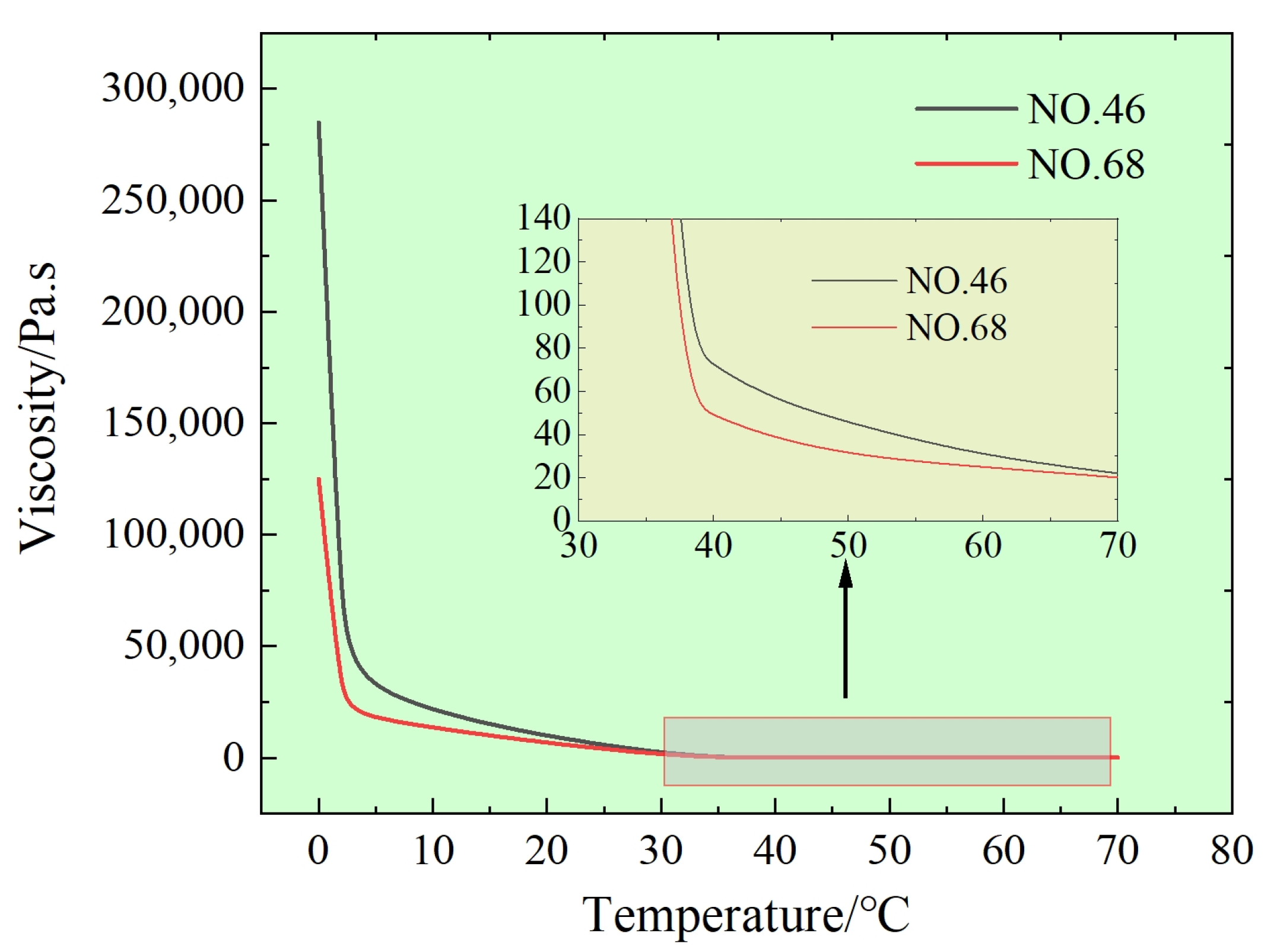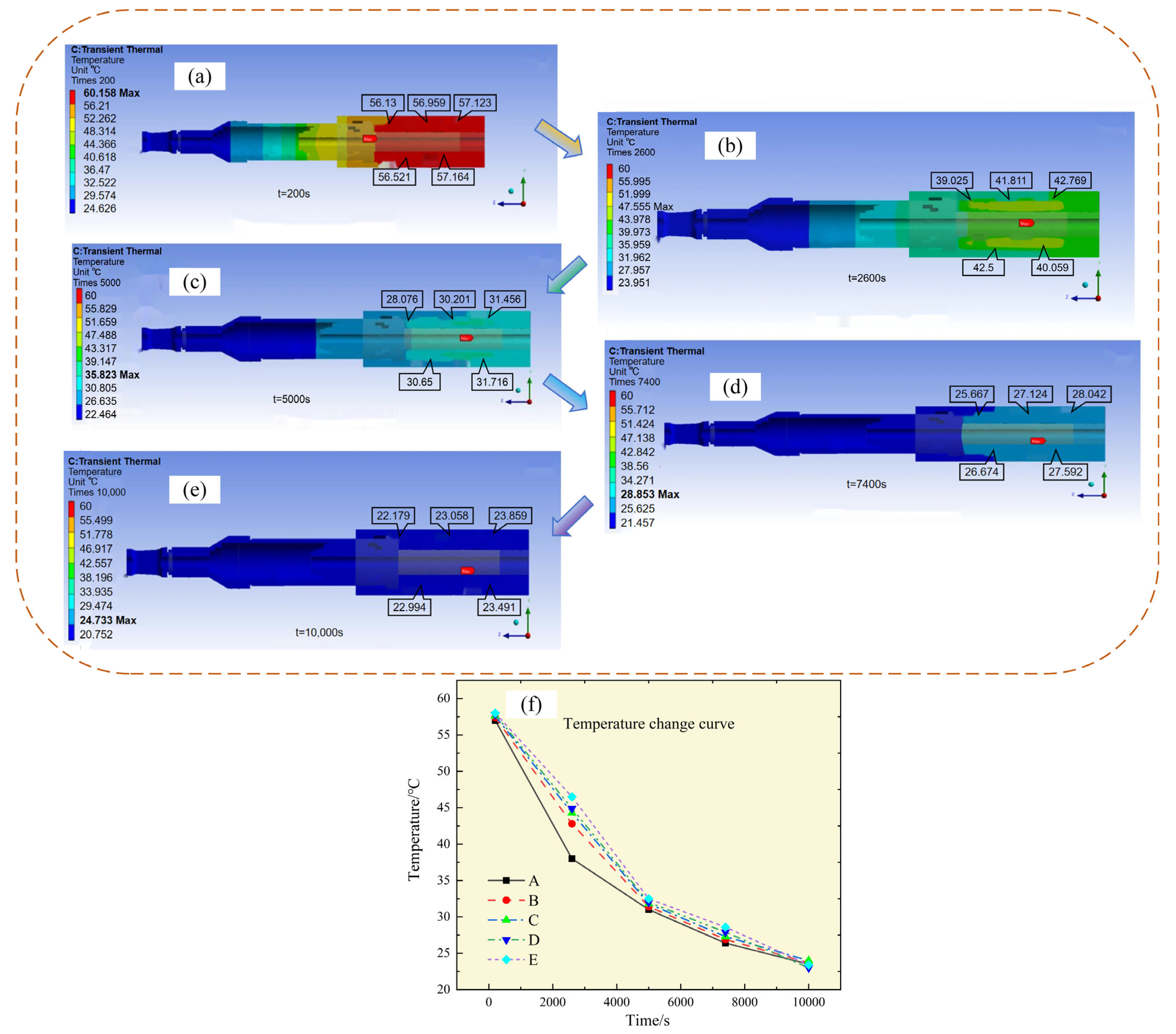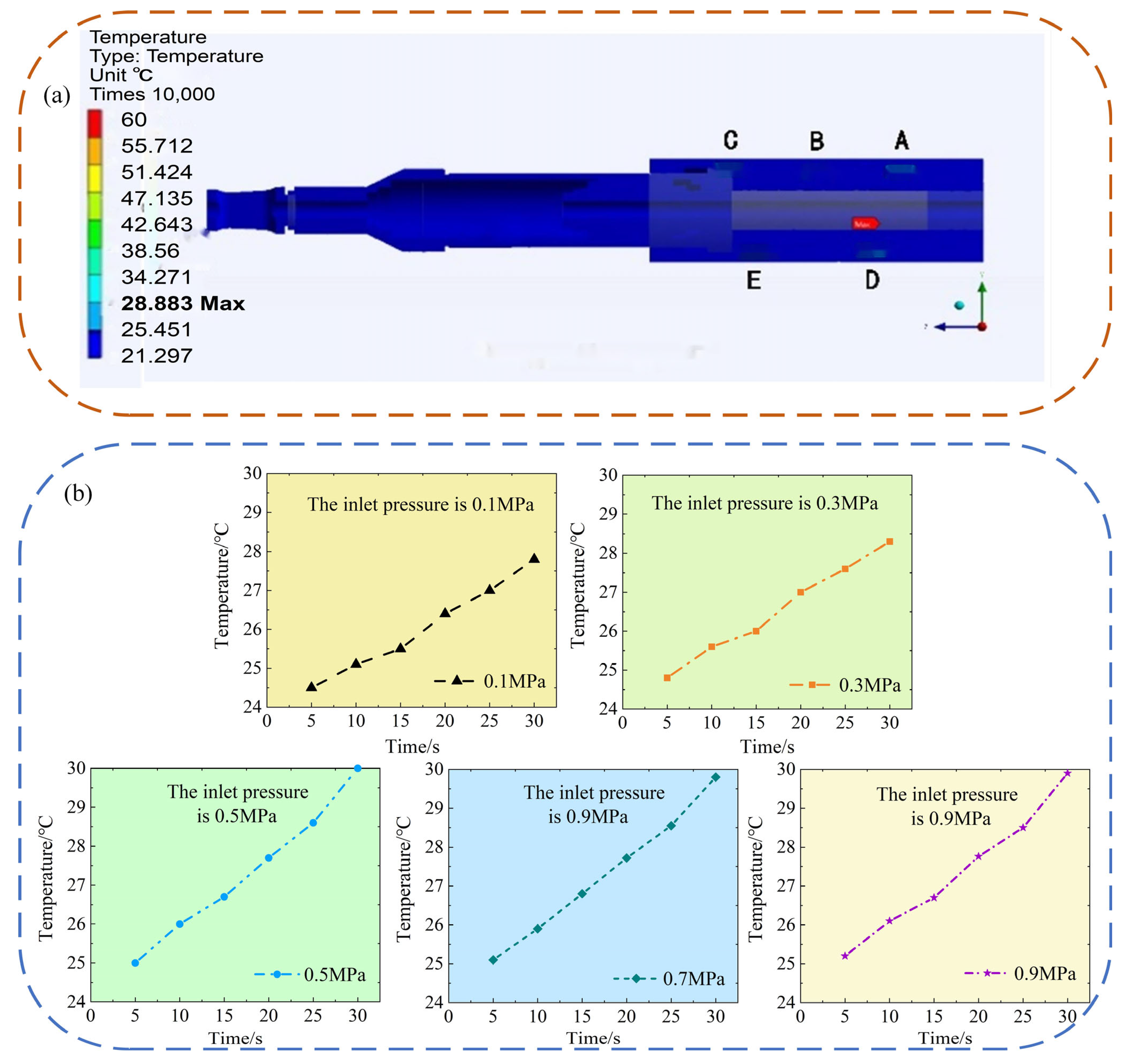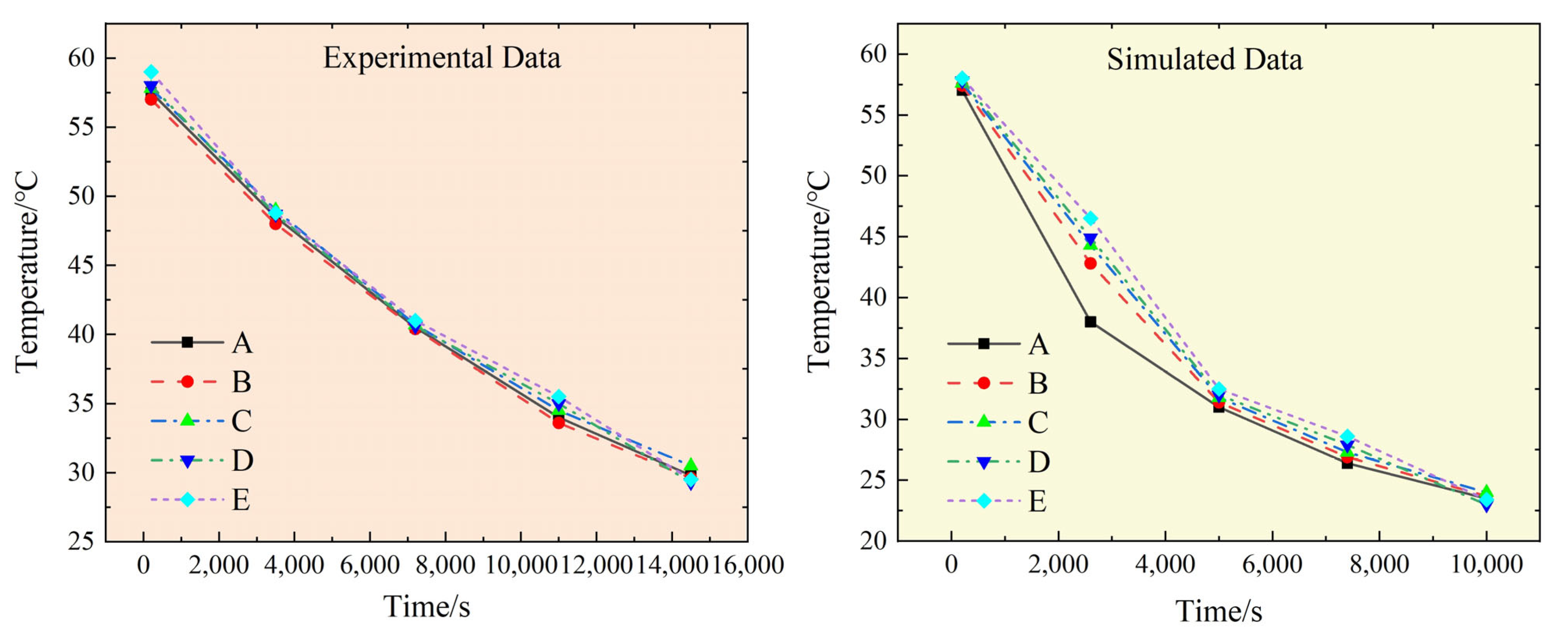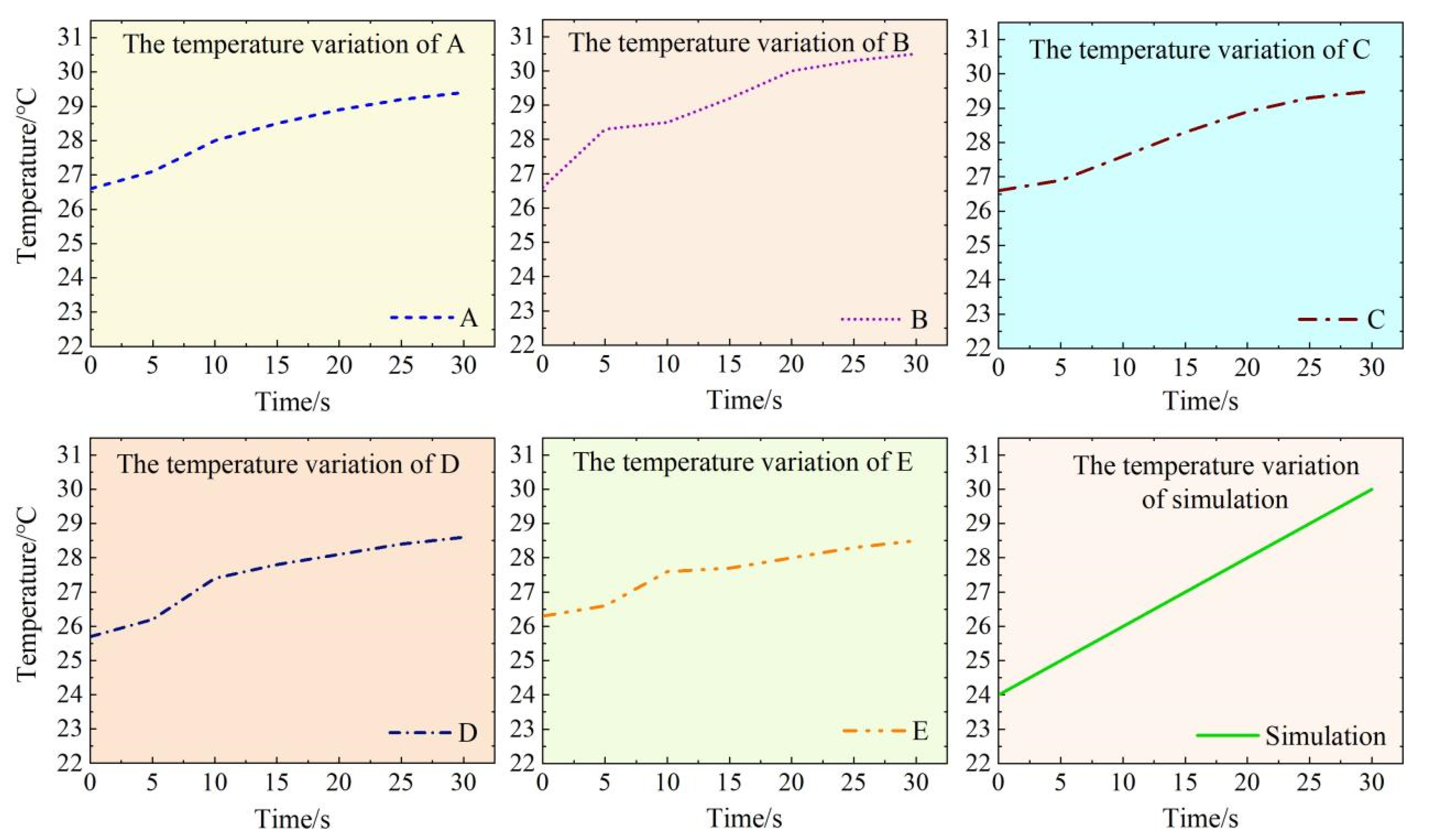2.1. Structure and Working Principle
The front hydraulic jack is mainly composed of the front, inside the steel outer cylinder body, piston rod, pipe jacking, clip locked plates, clamping shell cover, inside the handle, the cylinder lock block, the clamping piece back tube, clip casing, the bottom of the cylinder locking cap, the bottom of the cylinder, spring sheath, inner hexagonal cylindrical screw, cross recessed countersunk head screw and sealing ring (pad); its two-dimensional schematic diagram is shown in
Figure 1a, and its three-dimensional outline diagram is shown in
Figure 1b.
The front jack is mainly used for single-hole tension and can be used for porous pre-tightening, tension and barrier removal. The front tension jack needs to be used with the tension oil pump. The power of tension and jacking is provided by the high-pressure oil of the tension oil pump. When the front hydraulic jack is tensioned, it is against the working anchor; the working anchor is installed in the front end of the piston, and through the installation of the work and tool clamp, through the tension oil pump to the oil nozzle, and under the action of the high-pressure oil, the piston moves forward under the movement of the tool anchor, which drives the steel bundle to move forward, achieving the tension of the steel bundle.
The axisymmetric model is a special model simplification, it is suitable for those objects with axisymmetric properties. Because the structure of the front hydraulic jack has the characteristics of axial symmetry, this model can further reduce the calculation amount and improve the solving efficiency. At the same time, the axisymmetric model can maintain sufficient accuracy to ensure the reliability of the analysis results. Through the use of the finite element method for thermodynamic analysis, reasonable simplification of the jack structure, and the establishment of a 3D axisymmetric model, the calculation accuracy can be guaranteed and the solving efficiency can be significantly improved. This will provide strong support for the subsequent optimization simulation and experimental analysis in the following research. The three-dimensional cross-section schematic diagram of the front hydraulic jack is shown in
Figure 1c.
2.2. Theoretical Basis of Heat Conduction
There are two main methods of heat transfer in thermodynamics: thermal conductivity and convection. The thermal radiation effect of the jack surface on the external environment is ignored. The internal solids and their contact interfaces, such as the housing of the jack, the cylinder, and the heat at the contact point between the cylinder and the piston are transferred using heat conduction. When the hydraulic oil flows along the solid surface inside the jack, heat is exchanged through thermal convection. The hydraulic oil flows into the jack under the push of external pressure; so, the heat exchange between it and the inner wall of the jack belongs to the type of forced convection.
In this paper, the jack and its internal modules need to carry out heat transfer and heat conduction; these two ways are analyzed through Formula (1), which is based on the differential equation of heat flux and temperature relationship:
where
is temperature,
is thermal conductivity, and
is the heat produced per unit volume by the reservoir.
Steady-state heat conduction is a heat conduction process in which the temperature of an object does not change with time. In this process, the incoming and outgoing heat are equal; so, it is called thermal equilibrium. In the mathematical description of the steady-state heat conduction problem, the governing equation of the two-dimensional, constant physical, no internal heat source, steady-state heat conduction problem in the region n with boundary r can be expressed in a specific form in the polar coordinate system. In addition, there are no initial conditions in the definite solution of the steady-state heat conduction problem, only the boundary conditions. The thermodynamics of the jack belong to this phenomenon; so, when conducting thermodynamic research on it, it is necessary to consider many aspects, such as the differential equation of thermal conductivity and boundary conditions. Formula (1) is the differential equation of heat conduction of a jack, and the basic law expressed in it represents the basic law of internal thermodynamics of a jack, and Formula (2) is the formula for the boundary conditions of a jack [
5].
Formula (3), which describes the quantitative relationship between the temperature difference and the heat transfer rate in the convective heat transfer process, provides a powerful tool for in-depth discussion of the temperature field distribution inside the jack.
where
is the convective heat transfer coefficient,
is the wall temperature of a solid,
is the wall temperature of the fluid, and
is the heat flux density of convection heat transfer.
In practical engineering applications, to analyze various convective heat transfer problems, approximate convective heat transfer coefficients are usually obtained according to empirical formulas, as shown in Formula (4):
where
is the equivalent diameter of the fluid tube, and
is the Nusselt number. As can be seen from Equation (4), to obtain the convective heat transfer coefficient, it is also necessary to calculate the dimensionless heat transfer directive-Nusselt number of the fluid. This coefficient is associated with the Prandt number and the Reynolds number, and the three coefficients above are closely related to the flow state of the liquid.
The correlation between the rate of change in the thermal strain of an object with time and its rate of temperature change can be revealed by the instantaneous coefficient of thermal expansion, as shown in Equation (5):
where
is the ratio of thermal strain alteration,
is the temperature alteration ratio, and
is the instantaneous thermal expansion coefficient with temperature.
Without considering the anisotropy of the coefficient of thermal expansion, it is considered that the coefficient is consistent in different directions of the object [
17]. Both sides of Equation (5) are integrated at the same time to obtain the thermal strain expression:
where
is the actual temperature,
is the thermal strain, and
is the reference temperature.
When the shell of No. 45 steel jack is subjected to the internal flow of high-temperature fuel, its temperature will continue to rise. In this heating process, the increase in the temperature of the shell and the increase in the coefficient of thermal expansion of the material will interact with each other, resulting in an increase in the thermal strain of the shell, and once the thermal equilibrium state is reached, the thermal strain of the shell will reach its peak. The load on the jack unit body can be expressed as follows:
where
is the transition matrix,
is the elastoplastic coefficient matrix dependent on temperature,
is the change in node displacement,
is the equivalent pressure, and
is the temperature difference.
It can be seen from Equation (7) that all the loads subjected to the element include the load generated by the equivalent external force and the equivalent thermal load generated by the thermal strain. In the stress–strain analysis of the body, if the external force is ignored, the thermal strain inside the body will dominate and become the main contributor to the total strain.
2.4. Viscosity–Temperature Characteristics of Hydraulic Oil
At present, the commonly used viscosity–temperature relationship is the Roelands formula, which is a relatively accurate relation between dynamic viscosity and pressure and temperature, which can be expressed as in Equation (9) [
8]:
where
is the dynamic viscosity at pressure
and temperature
,
represents the dynamic viscosity at temperature
, and
and
are constants.
The front jack generally uses No. 46 or No. 68 anti-wear hydraulic oil as the working medium. In this paper, the No. 46 anti-wear hydraulic oil is used in both the simulation and the experiment, and the pressure magnitude is 106; so, the influence of pressure on the oil viscosity is ignored [
18]. The change in oil density with temperature is small and can be ignored. Equation (10) is simplified to obtain:
where
is the absolute temperature of oil, and
is 300 K. The numerical change in oil viscosity at different temperatures is shown in
Figure 2. As can be seen from the figure, the viscosity of oil varies greatly between 0 °C and 40 °C, gradually stabilizes after 40 °C, and is very sensitive to temperature change.
2.5. Regression Equation of Tensioning System
A regression equation is a mathematical expression that reflects the regression relationship between one variable (dependent variable) and another or a group of variables (independent variable) through regression analysis based on sample data. This expression describes the relationship between the dependent variable and the independent variable and can be used to predict the value of the dependent variable. In the factory calibration of tensioning systems, regression equations are often used to describe the relationship between the input force (hydraulic pressure) and the output force (tension), and to make predictions and interpretations based on this relationship.
According to JJG 621-2012 [
19] “hydraulic jack” verification regulations, generally according to the least square method, set the fitting equation, and then the linear regression equation can be obtained:
where
is the dependent variable (tension),
is the independent variable (hydraulic pressure),
is the slope,
is the intercept, and
is the correlation coefficient. The most commonly used form of the regression equation is the linear regression equation, which describes a linear relationship that can be expressed as
. The establishment of a regression equation usually needs to go through a series of data analysis processes, including data collection, data cleaning, model selection, parameter estimation, and model validation. In factory calibration, these data usually come from the input and output values of the actual measurement, and the parameters of the regression equation are obtained through statistical analysis to establish the relationship model between the input and output.

